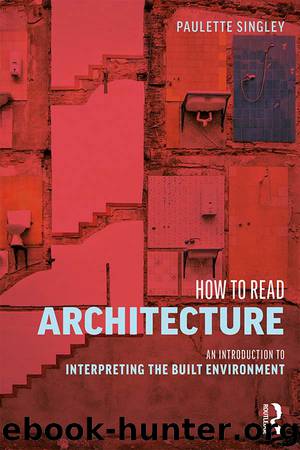How to Read Architecture by Singley Paulette;

Author:Singley, Paulette;
Language: eng
Format: epub
Publisher: Taylor & Francis (CAM)
Published: 2019-02-26T16:00:00+00:00
Non-structural Enclosure
Among Semper’s four elements and five techniques, woven mats, rugs, and complex knots locate architectural origins as coinciding with the beginning of textiles. For Semper, animal pens made of woven fences composed of tied sticks and branches introduced the earliest architectural constructs. The carpets that originally attached to supporting structures as enclosing membranes maintained vestiges of this role as hanging tapestries. For Semper, clothing referenced fabric enclosures through the German language’s rich linguistic connotation of the words Wand or wall and Gewand or garment. He also pointed out that the term Bekleidung or cladding also references Kleiden, meaning to clothe or to dress. Semper’s theory that textiles clothe buildings, expressed as his Bekleidungsprinzip or “dressing principle,” recalibrated previous theories of architectural origins in terms of global references and traditionally feminine arts.
Renzo Piano’s design for the Centre Culturel Jean-Marie Tjibaou in the southwest Pacific Ocean’s island cluster of New Caledonia (1998) derives inspiration from traditional Melanesian Kanak chiefs’ houses and other Kanak building techniques, taking Semper’s argument full-circle. Combining industrially produced materials such as glass, aluminum, and steel with traditional wood and stone, Piano referenced Kanak woven vegetable fiber huts through a series of pavilions wrapped in porous walls made of wooden ribs and slats. The exterior enclosures of these buildings configure high-performance passive ventilation systems, with resultant forms also evoking images of inhabitable parabolic baskets whose woven walls remain in a state of permanent completion. And finally, Bernard Cache and Patrick Beaucé of L’atelier Objectile translated the Bekleidungsprinzip into the digital language of contemporary architecture with their “Semper Pavilion” (1999). They transposed Semper’s bekleidungsprinzip into software applications to facilitate the computer milling of two-dimensional wood panels forming a topology of interlacing digital knots.
Figure 7.22 William LeBaron Jenney, Home Insurance Building in Chicago, Illinois (1885), from the United States Library of Congress’s National Digital Library Program under the digital ID mhsalad.250058
Download
This site does not store any files on its server. We only index and link to content provided by other sites. Please contact the content providers to delete copyright contents if any and email us, we'll remove relevant links or contents immediately.
| American National Standards Institute (ANSI) Publications | Architecture |
| History | Measurements |
| Patents & Inventions | Research |
Whiskies Galore by Ian Buxton(41939)
Introduction to Aircraft Design (Cambridge Aerospace Series) by John P. Fielding(33093)
Small Unmanned Fixed-wing Aircraft Design by Andrew J. Keane Andras Sobester James P. Scanlan & András Sóbester & James P. Scanlan(32764)
Craft Beer for the Homebrewer by Michael Agnew(18197)
Turbulence by E. J. Noyes(7978)
The Complete Stick Figure Physics Tutorials by Allen Sarah(7338)
Kaplan MCAT General Chemistry Review by Kaplan(6900)
The Thirst by Nesbo Jo(6881)
Bad Blood by John Carreyrou(6583)
Modelling of Convective Heat and Mass Transfer in Rotating Flows by Igor V. Shevchuk(6406)
Learning SQL by Alan Beaulieu(6237)
Weapons of Math Destruction by Cathy O'Neil(6216)
Man-made Catastrophes and Risk Information Concealment by Dmitry Chernov & Didier Sornette(5956)
Digital Minimalism by Cal Newport;(5704)
Life 3.0: Being Human in the Age of Artificial Intelligence by Tegmark Max(5516)
iGen by Jean M. Twenge(5385)
Secrets of Antigravity Propulsion: Tesla, UFOs, and Classified Aerospace Technology by Ph.D. Paul A. Laviolette(5333)
Design of Trajectory Optimization Approach for Space Maneuver Vehicle Skip Entry Problems by Runqi Chai & Al Savvaris & Antonios Tsourdos & Senchun Chai(5037)
Pale Blue Dot by Carl Sagan(4954)
